
Hello everyone! Today I bring the continuation of my trip in Italy. I visited Herculaneum and Pompeii on the same day, both are located in the province of Naples, in the Campania region in the south of the country.
Both share the same past: they were razed to the ground and buried by the ashes of the Vesuvius volcano in 79 AD.
However, the difference is that Herculaneum was closer to the volcano than Pompeii, so the mixture of volcanic gases here reached a much higher temperature, so that the victims were instantly calcined, leaving only their skeletons.
¡Hola a todos! Hoy traigo la continuación de mi viaje por Italia. Visité Herculano y Pompeya en el mismo día, ambas están situadas en la provincia de Nápoles, en la región de Campania al sur del país.
Las dos comparten el mismo pasado: fueron arrasadas y enterradas por las cenizas del volcán del Vesubio en el año 79 d.C.
Sin embargo, la diferencia es que Herculano estaba más cerca del volcán que Pompeya, así que la mezcla de gases volcánicos aquí alcanzó una temperatura muy superior, de modo que las víctimas fueron calcinadas al instante quedando sólo su esqueleto.
 |  |  |
|---|
Images of the skeletons of Herculaneum, as they were found
Imágenes de los esqueletos de Herculano, tal y como los encontraron.
In Pompeii, on the other hand, the ash hardened around the bodies that still preserved the skin, which when they reached the state of putrefaction left the hollow shape.
The difference between them today is also that Herculaneum is smaller than Pompeii, and also less visited; so you can walk around it in a quieter way taking your photos almost in solitude.
In addition, Herculaneum has the city structures much better preserved than its neighboring city, so you can better appreciate the details of the life of its inhabitants. Although personally, I recommend visiting both of them if you have time because both are very worthwhile.
In order not to make the post too long, first I will tell you only about Herculaneum, and in the next days about Pompeii and the city of Naples😄.
En cambio en Pompeya, la ceniza se endureció alrededor de los cuerpos que conservaron todavía la piel, que al llegar al estado de putrefacción dejaron la forma hueca.
La diferencia también entre ellas a día de hoy es que Herculano es más pequeña que Pompeya, y también menos visitada; por lo que puedes recorrerla de manera más tranquila haciendo tus fotos casi en soledad.
Además, Herculano tiene las estructuras de la ciudad mucho mejor conservadas que su ciudad vecina, así que podrás apreciar mejor los detalles de la vida de sus habitantes. Aunque personalmente, recomiendo visitar las dos si tienes tiempo porque ambas merecen muchísimo la pena.
Por no hacer muy extenso el post, primero os hablaré sólo de Herculano, y en los próximos días sobre Pompeya y la ciudad de Nápoles😄.
Herculaneum
Herculano
As soon as we buy the ticket and cross the entrance, we see that the sea is just on one side, on the other side is the volcano, and we have to descend some stairs that were dug inside a mountain to reach the ruins.
Nada más comprar el ticket y cruzar la entrada, vemos que el mar está justo a un lado, al otro está el volcán, y tenemos que descender unas escaleras que cavaron dentro de una montaña para poder llegar a las ruinas.


In those excavated holes that you see on both sides of the walkway, is where the skeletons that I have shown you in the previous photos are.
We climb those steps and, I leave you some photos of what you can see:
On the right we will have a sculpture, and on the left a small "church" where they worshipped their gods.
En esos huecos excavados que veis a ambos lados de la pasarela, es donde están los esqueletos que os he mostrado en las fotos anteriores.
Subimos esos peldaños y, os dejo unas fotos de lo que se ve:
A la derecha tendremos una escultura, y a la izquierda una pequeña "iglesia" donde rendían culto a sus dioses.


We continue going up more steps and we arrive to the city itself. In it we can appreciate that the paintings of the houses are still preserved, both on walls and in the paintings that they had to decorate them. Art that today is perfectly preserved. In addition to the mosaics on the floor... Of course, they were very good at decorating.
Continuamos avanzando más escalones hacia arriba y ya llegamos a la ciudad propiamente dicha. En ella podemos apreciar que todavía se conservan las pinturas de las casas, tanto en paredes como en los cuadros que ellos tenían para decorarlas. Arte que a día de hoy se conserva perfectamente. Además de los mosaicos del suelo... Desde luego, eran muy buenos decorando.
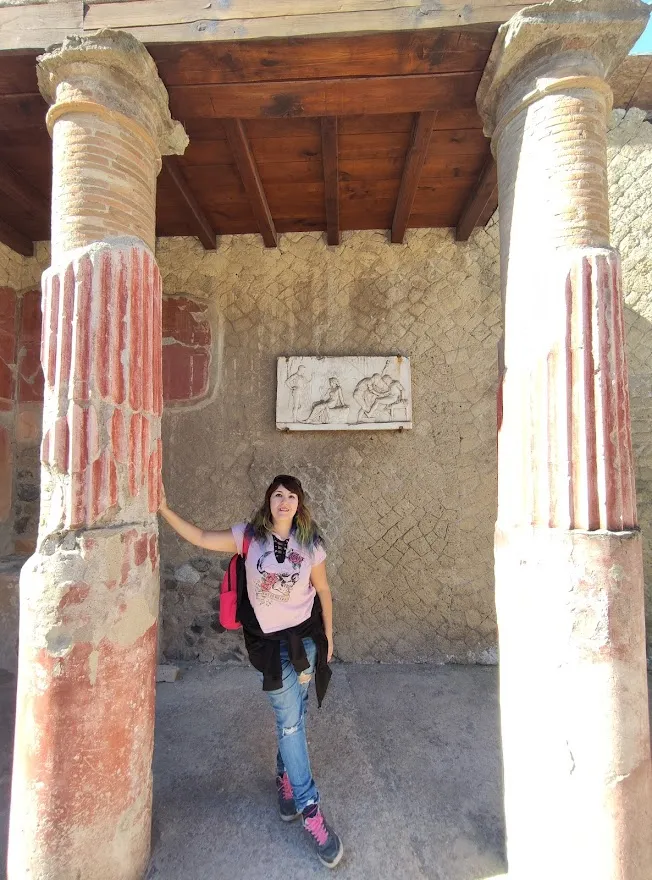
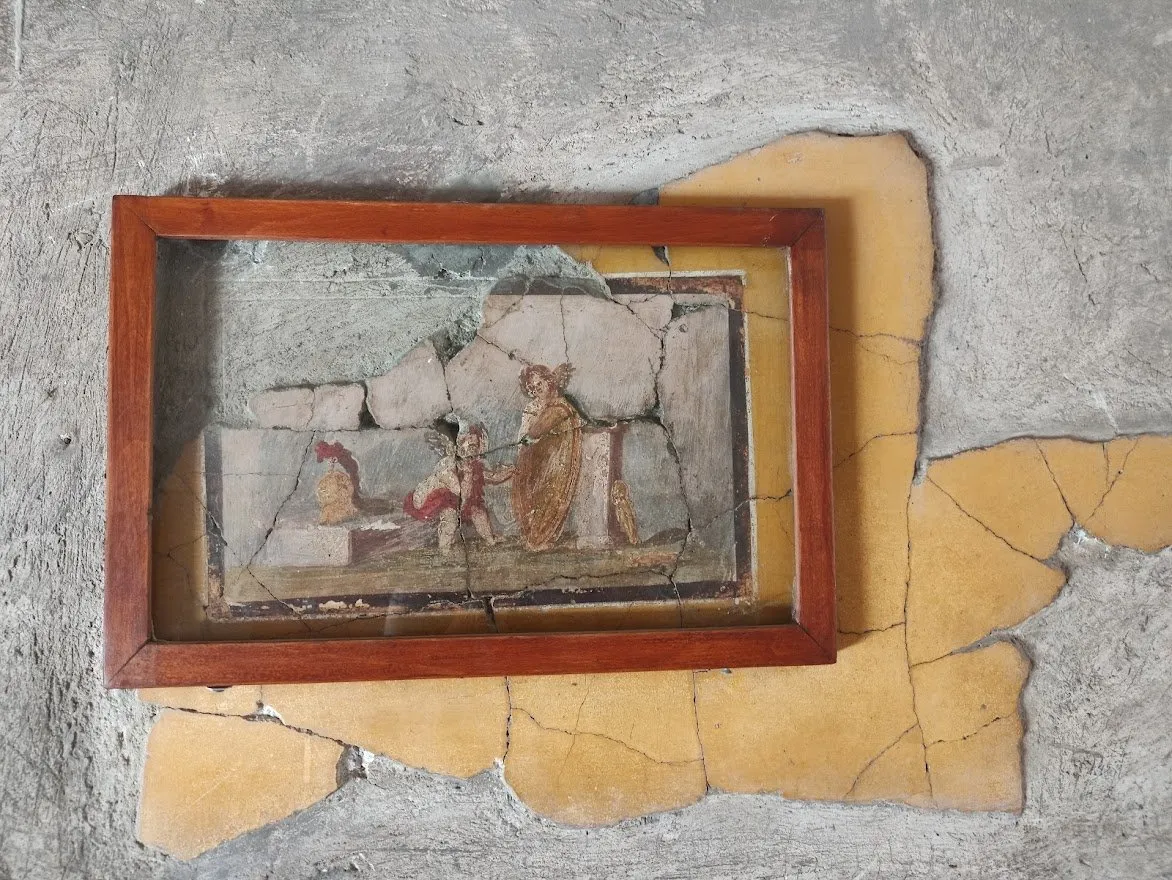 |  |
|---|
We arrived at what they call "the house of the Deer". In this city people were wealthier than in Pompeii, so we can find very interesting furniture and sculptures like the one I am going to show you, which among them is a doe suckling her young.
Llegamos a la que llaman "la casa del Ciervo". En esta ciudad la gente era más adinerada que en Pompeya, así que podemos encontrar mobiliario y esculturas muy interesantes como las que os voy a mostrar, que entre ellas es una cierva amamantando a sus crías.
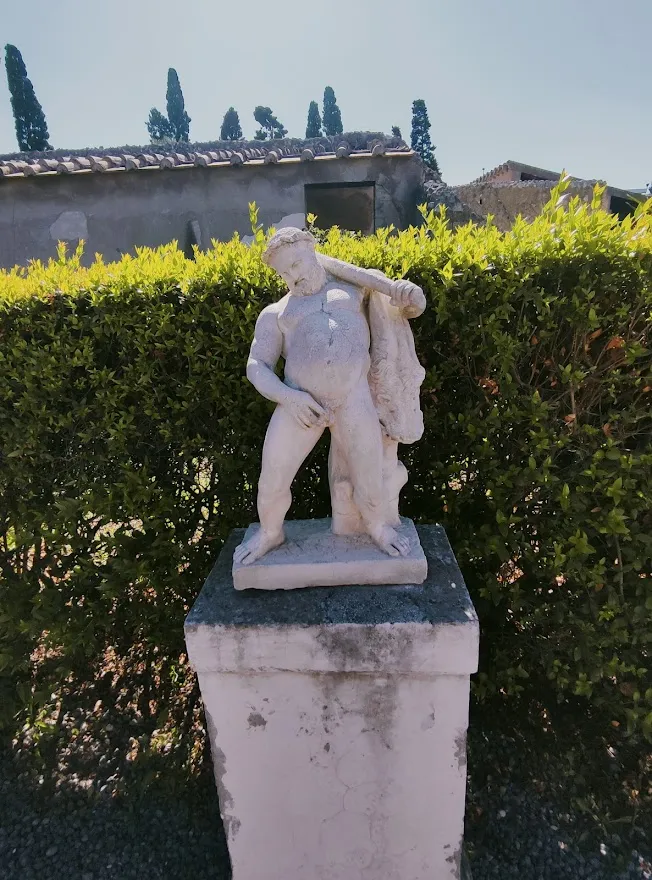 | 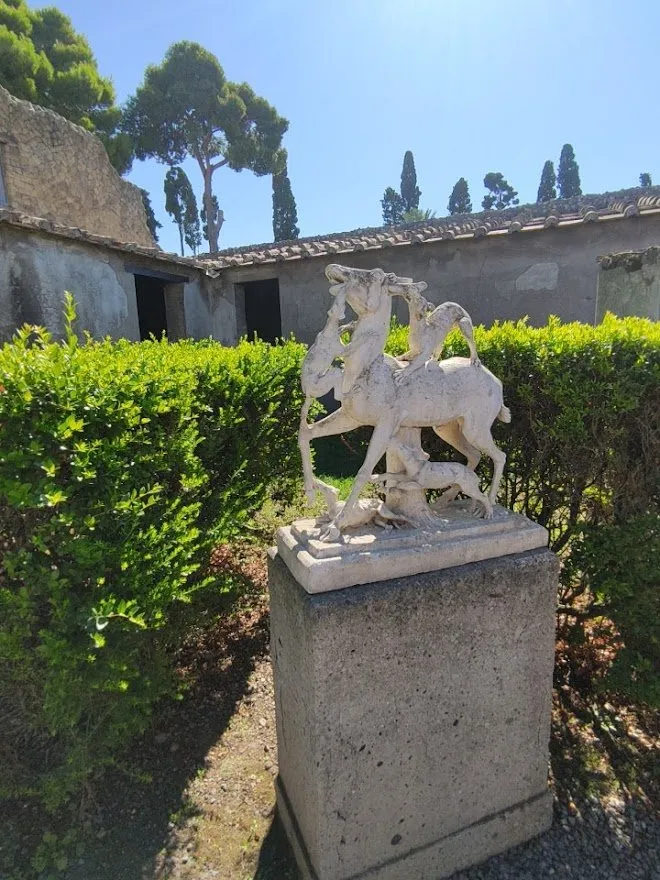 |  |
|---|
Seriously, the houses are true works of art.
En serio, las casas son auténticas obras de arte.



We arrived at the famous thermal baths, the public baths where they went not only for hygiene but also as a social gathering. What would become a "spa" in our days.
Llegamos a las famosas termas, los baños públicos donde no sólo acudían por higiene sino como reunión social. Lo que vendría a ser un "spa" en nuestros días.

Thermal baths seen from the outside
Termas vistas desde fuera
 |  |  |
|---|
Thermal baths seen from the inside
Termas vistas desde dentro
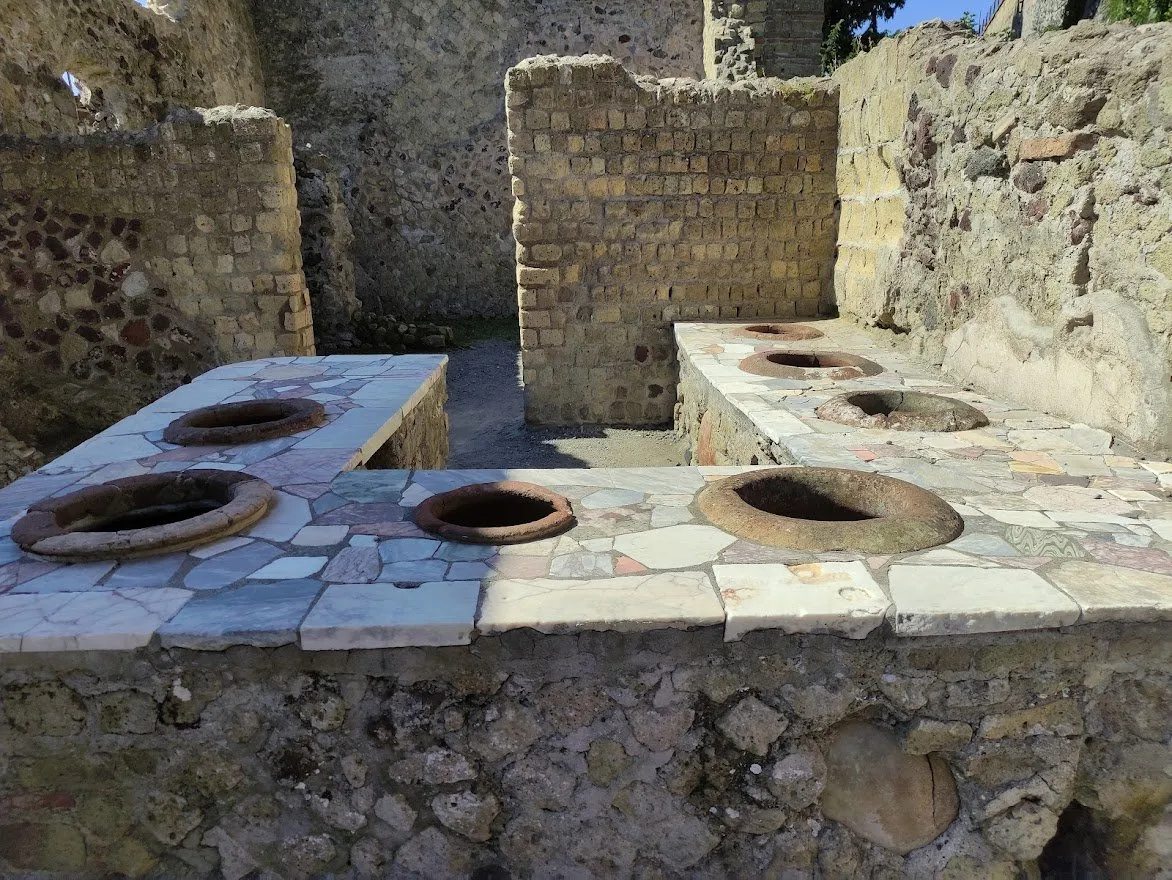
This was a canteen. This is where they stored the food.
Esto era una cantina. Aquí almacenaban los alimentos



Streets of Herculaneum
Calles de Herculano

Their old fountains are still working!
¡Sus antiguas fuentes todavía funcionan!
I took a lot of pictures, but here is a summary to give you a brief idea.
We said goodbye to Herculaneum and the views of the volcano.
Hice muchas fotos, pero aquí os presento un resumen para que tengáis una ligera idea.
Nos despedimos de Herculano y de las vistas al volcán.

When we left, it was time for lunch. We went to the place where we had the best pizzas of our entire stay in Italy: "Ristorante Da Ernesto".
As a starter we ordered an assorted plate of cold cuts, olives and peppers.
Al salir se nos había hecho la hora de comer. Acudimos al lugar donde comimos las mejores pizzas de toda nuestra estancia en Italia: "Ristorante Da Ernesto".
De entrante pedimos un plato variado de embutidos, aceitunas y pimientos.

And for lunch, @vonjerico ordered a peculiar pizza that they served in this region of Italy: fried pizza! I had never seen it before, so it caught our attention.
It was also super cheap. I think I remember it cost just 3€ and it came well stuffed.
In my case, I wanted to go for something more traditional, I ordered a marinara pizza, which is like the margherita pizza (typical of Naples) but seasoned with tomato, garlic, oregano and olive oil, its price: 5€.
Y para comer, @vonjerico pidió una peculiar pizza que servían en esta región de Italia: ¡La pizza frita! Nunca la había visto, así que nos llamó la atención.
Además súper económica. Creo recordar que costó apenas 3€ y venía bien rellena.
En mi caso, quise tirar por algo más tradicional, pedí una pizza marinara, que es como la pizza margarita (típica de Nápoles) pero condimentada con tomate, ajo, orégano y aceite de oliva, su precio: 5€.
In my previous post, where I told you about my experience in Rome and the Vatican, I told you that the typical Roman pizza disappointed me because the dough was so thin that it broke. But friends, now we were in Naples, the region where the original pizza was born before its recipe spread to the rest of the world, and here there was really good pizza. My mouth is watering just looking at the pictures again.
Unlike the pizza I tried in Rome, this one had a thicker, juicier, fluffier dough, and the flavor was homemade and spectacular, plus it was half the price.
En mi anterior post donde os conté mi experiencia en Roma y en el Vaticano, os conté que la pizza típica romana me defraudó porque la masa era tan fina que se rompía. Pero amigos, ahora estábamos en Nápoles, la región donde nació la pizza original antes de que se extendiese por el resto del mundo su receta, y aquí sí que había pizza buena de verdad. Se me hace la boca agua sólo de volver a ver las fotos.
A diferencia de la pizza que probé en Roma, ésta tenía la masa más gordita, jugosa, esponjosa, y el sabor era casero y espectacular, además de que nos costó la mitad de precio.
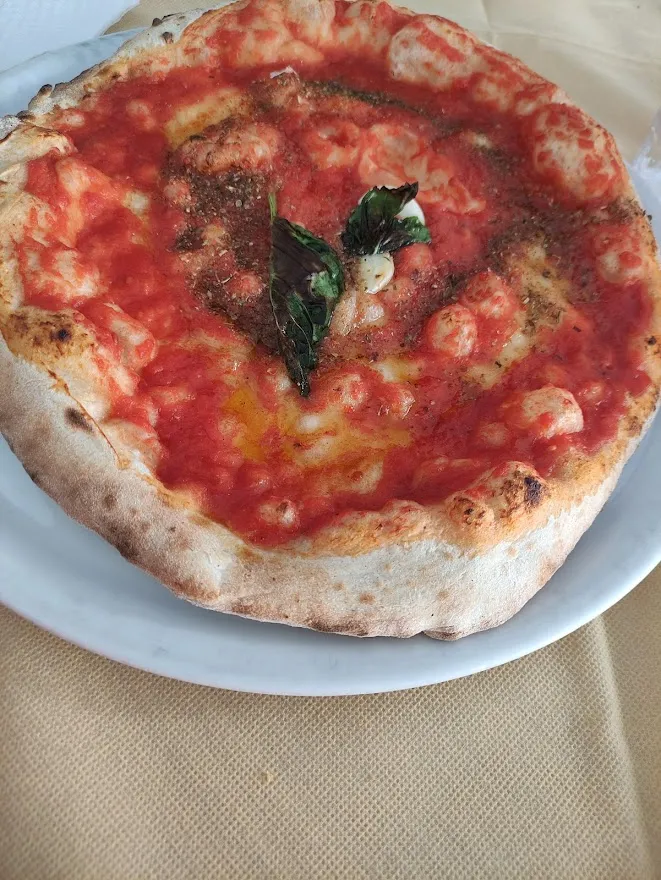 |  |
|---|
Pizza marinara
 |  |
|---|
Fried pizza, well stuffed with buffalo mozzarella cheese and salami.
Pizza frita, bien rellena de queso mozzarella de búfala y salami
For dessert, Ruben ordered a tartuffo and I had a tiramisu, they also looked homemade and were very good.
De postre, Rubén pidió un tartuffo y yo un tiramisú, también parecían caseros y estaban muy buenos.
 |  |
|---|
All photos have been taken by me, with my Xiaomi phone, or by my companion on the trip @vonjerico with his Xiaomi phone too, who has given me permission to publish them.
Todas las fotos han sido tomadas por mí, con mi móvil Xiaomi, o en su defecto por mi acompañante en el viaje @vonjerico con su móvil Xiaomi también, quien me ha dado permiso para publicarlas.
Other trips
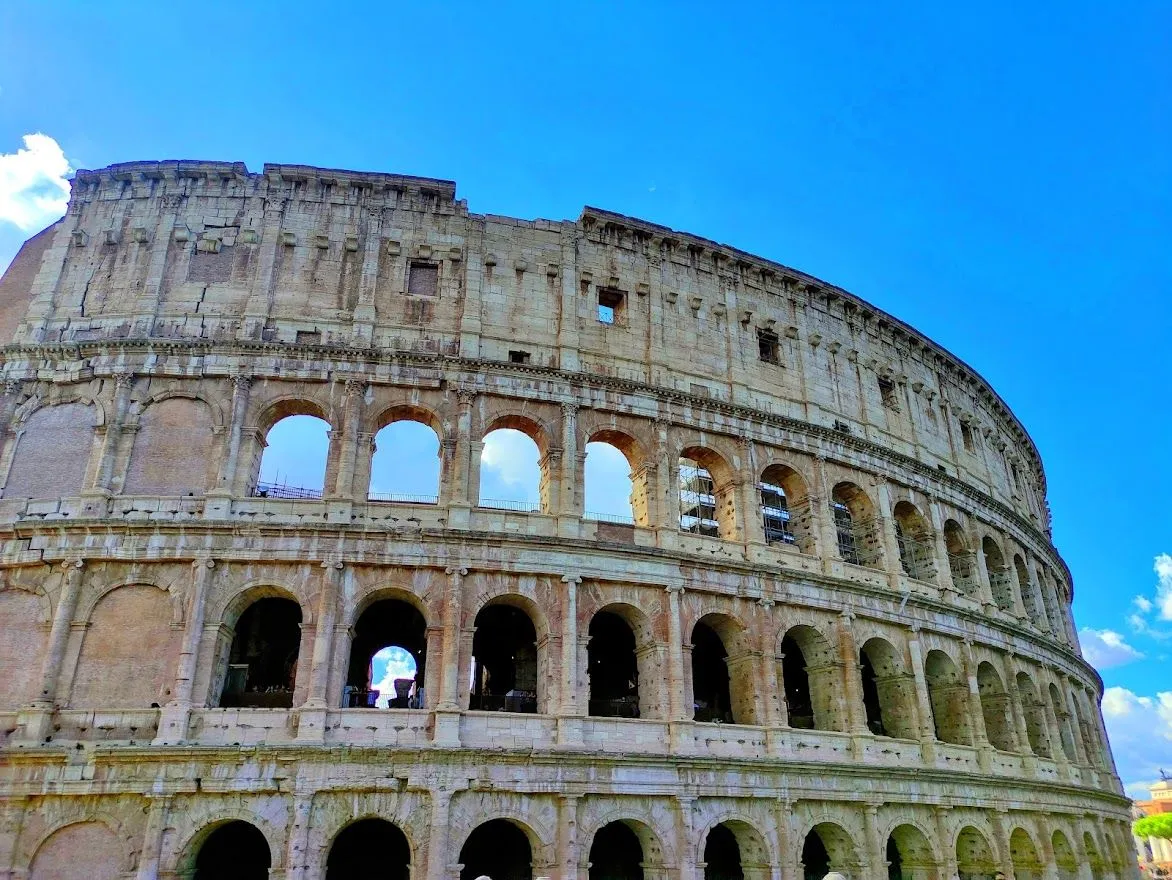 | |
|---|---|
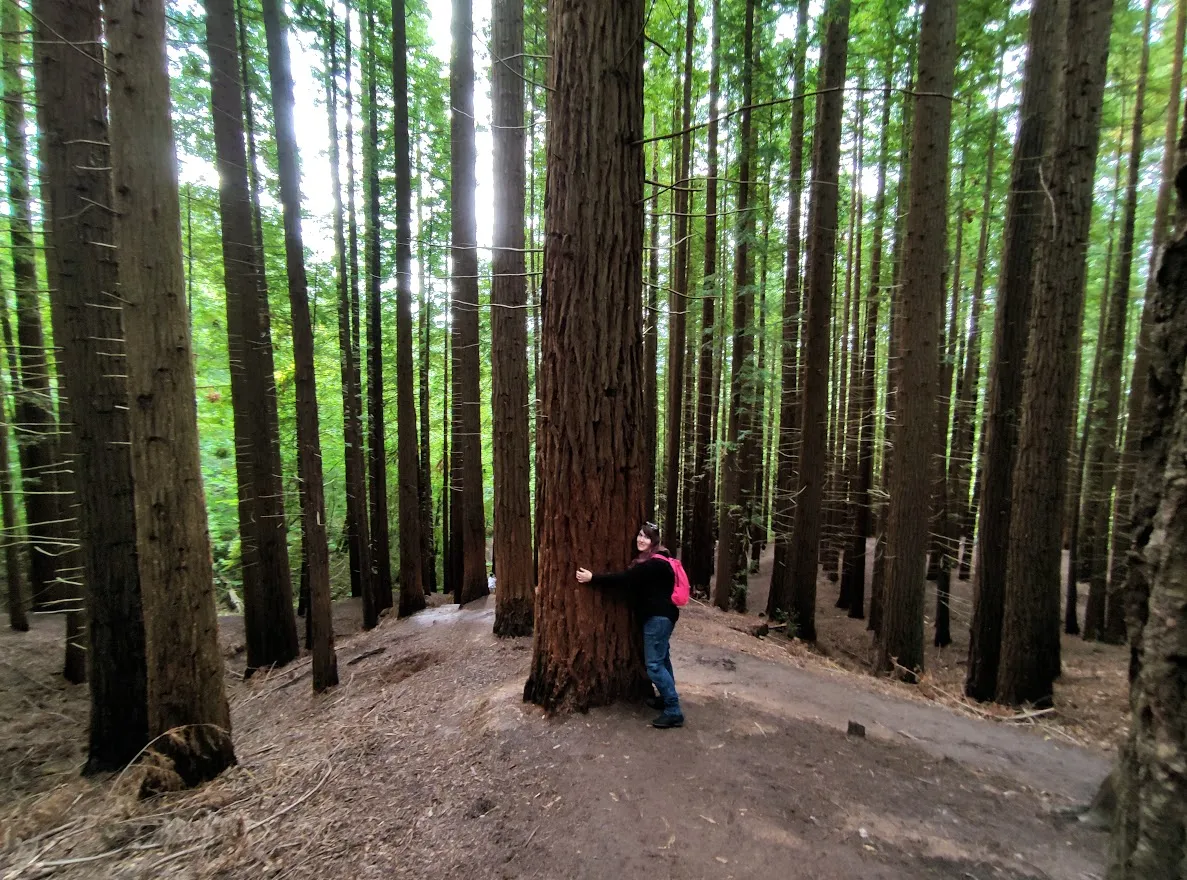 |
My social networks/Mis redes sociales:
Writer Instagram | Travel Instagram | Twitter | Facebook| Linktree
